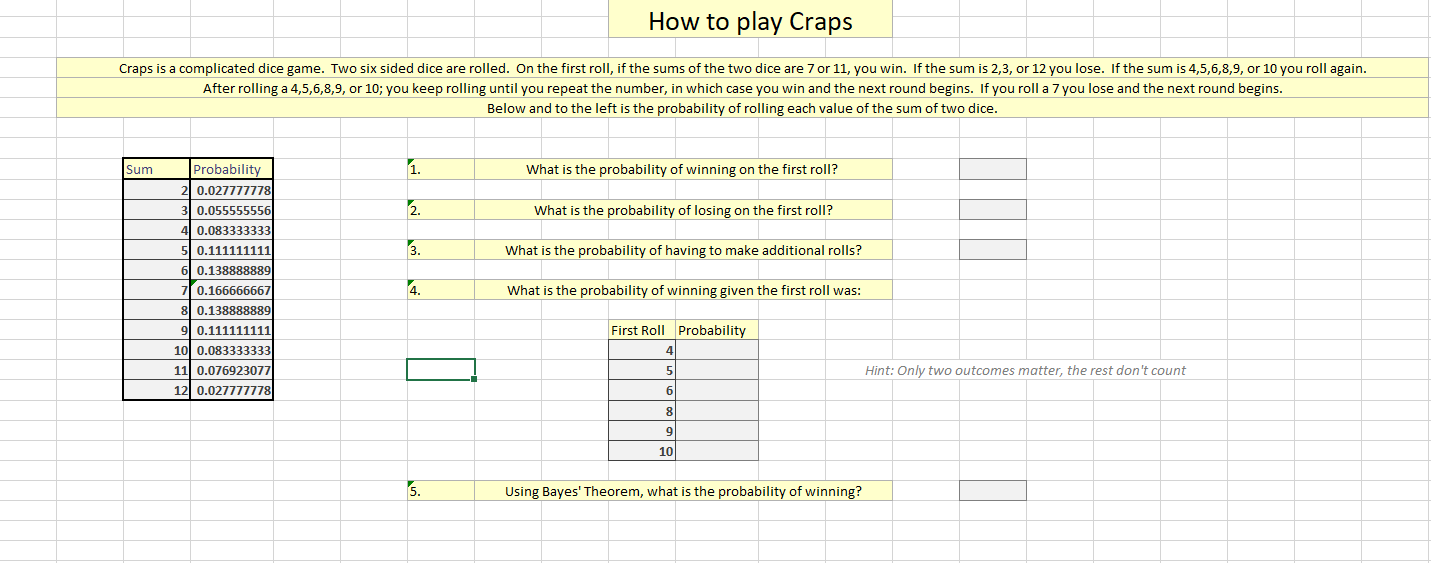Probability Of Winning Craps On First Roll
The Game
- Probability Of Winning Craps On First Roll Poker
- Probability Of Winning Craps On First Roll Wrappers
- Probability Of Winning Craps On First Roll Hall Of Fame
(Note that the probability of rolling a 1 with 2 dice is zero; the P element is not used for any computations.) You can use the table to compute the probability of winning at craps. If you roll a 7 or 11 on the first roll, you win. If you roll a 2, 3, or 12, you lose. First of all, the actual odds of winning this bet are 5:4. The payouts are even (1:1) when the shooter rolls a 3, 4, 9, 10 or 11. The payouts are 2:1 when they roll a 2 or 12 (snake eyes or boxcars). Although, some casinos will be generous enough to pay out 3:1 odds on these two numbers if they win on the field bet. This video is made for a specific course in which we cover just a bit of probability. The actual calculation should be possible to follow for a good high-school student, but thinking through the.
You can use probability to figure out the odds of winning and losing in the popular casino dice game of craps. In the game of craps, on your first roll (called the come out roll), three outcomes are possible: Natural: Rolling a total of 7 or 11 — automatically wins. Craps: Rolling a total of 2, 3, or 12 — automatically loses.
Craps is a dice game where two dice are rolled and the sum of the dice determines the outcome.
- If the sum is a 7 or 11, you win and the game is over.
- If the sum is a 2, 3, or 12, you lose and the game is over.
- If you roll a 4, 5, 6, 8, 9, or 10, that value becomes your 'point' and you continue to roll until you re-roll your point or a 7. If you roll your point, you win; if you roll a 7, you lose.
Video: Use Real Player to listen to the instructions and watch several games to make sure you understand the game. (56k - DSL/Cable)
Some of the probabilities are easy to find. The fundamental counting principle tells us there are 6*6=36 ways to roll two dice, all of them equally likely if the dice are fair. There is only one way to roll a sum of 2 (snake eyes or a 1 on both dice), so the probability of getting a sum of 2 is 1/36. There are 4 ways to get a five (1-4, 2-3, 3-2, 4-1) so the probability of getting a five is 4/36. The probabilities of obtaining any of the first roll sums can be found fairly easily and are shown in the table below.
Probabilities of Sum on First Roll| Sum | 2 | 3 | 4 | 5 | 6 | 7 | 8 | 9 | 10 | 11 | 12 |
| Probability | 1/36 | 2/36 | 3/36 | 4/36 | 5/36 | 6/36 | 5/36 | 4/36 | 3/36 | 2/36 | 1/36 |
We can find the probability of winning, losing, or obtaining a point on the first roll of the game by adding up the probabilities for the sums that go with winning, losing, or getting a point. For example, since a 7 or an 11 is a winner on the first roll and their probabilities are 6/36 and 2/36, the probability of winning on the first roll is 6/36+2/36=8/36.
Probabilities of Winning, Losing, or Getting a Point on First Roll
| Outcome | Win | Lose | Point |
| Probability | 8/36 | 4/36 | 24/36 |

The Point
The main problem with game of craps is that it can theoretically go on forever when a point is obtained on the first roll. Now, in actual practice, it doesn't. Eventually, you are going to either re-roll that point and win or roll a 7 and lose.
But, becasue you could theoretically go on forever, finding the probabilities involve an infinite geometric series. As an example, consider the case when the point is a 9 that is shown in the tree diagram to the right. Once you roll a 9, there is a 4/36=1/9 chance of rolling it again on any roll and a 6/36=1/6 chance of rolling a 7 and losing. However, there is a 13/18 chance that you will roll neither and the game will continue for another round.
There is a 1/9 chance of winning on the second roll (the first after the point), a 13/18*1/9=13/162 chance of winning on the third roll, a 13/18*13/18*1/9=169/2916 chance of winning on the fourth roll. But it doesn't stop there, it keeps going, and going, and going. Then you have to add all those probabilities up and that involves an infinite geometric series. That might not be difficult for you, but since the prerequisite for the applied statistics course is just intermediate algebra, most of the students have never seen an infinite geometric series.
So, there has to be another way.
The Simulation
This is a game that is most fun when it is simulated using actual dice. Sure, it would be possible and quicker to simulate it using a computer, but it wouldn't be nearly as fun.
Here's how the simulation works. Roll a pair of dice and record the sum in the table where it says 'Sum on first roll'. We are then going to record the result of the first roll as 'Win', 'Lose', or 'Point' in the table where it says 'Result of first roll'. If the sum is a 2, 3, 7, 11, or 12, go ahead and copy the first roll results into the overall results column and move on to the next game. If you have rolled a point, continue to roll the die until you roll either that point or a 7, but do not record the value of each of those rolls. Once you have rolled your point or a 7, then record either 'Win' or 'Lose' in the table for the overall results. You may wish to abbreviate the results as 'W', 'L', or 'P'.
| Game | Sum on first roll | Result of first roll | Overall Result |
|---|---|---|---|
| 1 | |||
| 2 | |||
| 3 | |||
| 4 | |||
| 5 |
The Analysis
After you have played several games (I recommend 36 since there are 36 different outcomes possible and it makes the probabilities nicer), it's time to sit back and look at what you have gathered.
First Roll Probabilities
Go through and count how many times each sum appeared as the first roll of the dice. Record it in the table below as a fraction over the total number of rolls and compare it to the theoretical probabilities we found earlier.
| Sum | 2 | 3 | 4 | 5 | 6 | 7 | 8 | 9 | 10 | 11 | 12 |
| Observed | |||||||||||
| Theoretical | 1/36 | 2/36 | 3/36 | 4/36 | 5/36 | 6/36 | 5/36 | 4/36 | 3/36 | 2/36 | 1/36 |
Are the observed probabilities close to the theoretical probabilities? They should get closer as you simulate more crap games (law of large numbers).
First Roll Outcomes
Now add the number of times you got a win, lose, or point on the first roll of the dice and write that as a fraction. If you played the game right, this can also be found by adding the probabilities of getting a win (7 or 11), lose (2, 3, or 12), or point (all else) together.

Record them in the table below and compare them with the theoretical probabilities found by adding the theoretical probabilities as mentioned in the last paragraph or that we found earlier in this document.
| Outcome | Win | Lose | Point |
| Observed | |||
| Theoretical | 8/36 | 4/36 | 24/36 |
Final Results

You're probably thinking to yourself that this has been pointless. So far, we haven't found anything that we couldn't find through simple probabilities and it was much quicker and more accurate (exact instead of an approximation).
Probability Of Winning Craps On First Roll Poker
What we're really interested in finding is the final outcomes of the game; that is, the probabilities of winning or losing the whole game. Count how many times you won and lost for the overall results and write that as a fraction over the total.
| Outcome | Win | Lose |
| Observed | ||
| Theoretical | 244/495 | 251/495 |
Did your results come out close to the theoretical results (found using infinite geometric series or absorbing markov chains)? You should have lost a few more games than you won. Well, after all, the casinos want to make money, don't they?
Probability Of Winning Craps On First Roll Wrappers
Type of Simulation
This is a simulation used to find probabilities. In this kind of simulation, you conduct an experiment and ultimately find the number of successes divided by the number of trials to find the relative frequency or the empirical probability. Success is defined as whatever you're trying to find the probability of. So, if you're looking for the probability of rolling a 6, then it is the number of 6's over the total number of rolls. If you're trying to find the probability of losing the game, then it is the number of losses divided by the total number of games.
Probability Of Winning Craps On First Roll Hall Of Fame
Return to Simulation Page